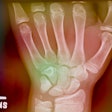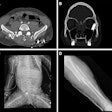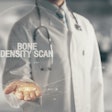A new study is highlighting the differences between digital radiography (DR) and conventional analog radiography in detecting abnormalities caused by dust-related lung diseases, or pneumoconiosis. The researchers say their work indicates that a commonly used classification system for pneumoconiosis should be updated to reflect the radiology community's increasing reliance on DR for chest imaging.
Radiography has long been the workhorse modality for diagnosing cases of pneumoconiosis, a range of fibrotic or granulomatous lung diseases related to the inhalation of dusts such as asbestos, silica, and coal. Since the 1930s, a classification system developed by the International Labour Organization (ILO) has been used to classify posteroanterior (PA) radiographs with signs of pneumoconiosis.
But the ILO system is based on film-screen radiography and hasn't been updated to reflect the market's shift to DR systems, according to a research group led by Dr. Alfred Franzblau of the University of Michigan School of Public Health in Ann Arbor. Franzblau and colleagues sought to investigate the impact of radiography image format on how readers characterize pneumoconiosis using the ILO criteria. Their results were published in the June 2009 issue of Academic Radiology (Vol. 16:6, pp. 669-677).
The researchers started with a patient population of 107 subjects, of whom 86 (80%) were male and 21 (20%) were female, with a median age of 65. Sixty patients (56%) had a history of dust exposure, with silica and asbestos being the most common elements. One case was lost in both the DR and film-screen groups, leaving researchers with 106 image sets for the 107 subjects.
Images were acquired between 2003 and 2005, and for each subject, a standard PA film-screen image and a PA DR image were obtained. DR images were acquired on a flat-panel Hologic DR1000C system (Hologic, Bedford, MA). For purposes of comparison with film-screen, DR images were either read on a PACS workstation (soft copy) or output to film with a laser printer and read on a lightbox (hard copy).
Because the ILO system was developed for film-screen radiography, it has no equivalent for DR, making side-by-side comparisons of film-screen and DR images problematic for the research team. To address this problem, Franzblau and colleagues digitized and archived the entire set of films used for the ILO reference standard and made them available to the physicians reading the films. The study's six readers were drawn from the pool of physicians certified by the U.S. National Institute for Occupational Safety and Health (NIOSH) for interpreting chest radiographs for pneumoconiosis (also known as B readers).
The B readers reviewed images in two rounds of readings; in each round, a reader would classify the film-screen, DR hard-copy, and DR soft-copy images according to the 2000 edition of the ILO classification system. Franzblau and colleagues then analyzed the extent to which the classifications agreed with each other for a variety of different pneumoconiosis conditions, such as parenchymal and pleural abnormalities, presence of large and small opacities, and image quality.
The researchers found that there was good agreement between film-screen and soft-copy DR in classifying parenchymal abnormalities, with the B readers using film-screen finding that 65% of patients had this condition, compared with 67% for soft-copy DR. There was less agreement for hard-copy DR, with the readers reviewing these types of images reporting that 71% of patients had parenchymal abnormalities.
Neither DR technique showed much agreement with film-screen x-ray for pleural abnormalities, the researchers noted. B readers reviewing film-screen images reported that 37% of subjects had pleural abnormalities, compared with 31% for hard-copy DR and 27% for soft-copy DR, a statistically significant variation.
On an image quality scale, the B readers found no significant differences between image quality of film-screen x-ray and soft-copy DR, with 92% of film-screen x-ray images receiving one of the top two image-quality ratings, compared with 91% percent for soft-copy DR. But hard-copy DR scored lower, with the readers rating 85% of these images with one of the top two scores.
The B readers' ability to recognize large lung opacities differed significantly across all three techniques, with readers using hard-copy DR reporting more opacities and those using soft-copy DR reporting the fewest.
Among the shortcomings of the study were that no "truth" was established for determining which of the three image presentation formats was most accurate for detecting actual pathology, the authors said. The study also used hard-copy DR images printed at 100% size, while many imaging facilities are known to laser print images at 66%, and reducing image size by 50% or more has been known to result in lower detection accuracy. The study also did not employ any digital image processing techniques.
The researchers concluded by stating that their study indicated that film-screen radiography and soft-copy DR can be "recommended for the recognition and classification of dust-related parenchymal abnormalities" under conditions similar to those used in the study. But because both soft-copy and hard-copy DR differed significantly from film-screen for pleural abnormalities, the role of DR for this condition requires further study.
By Brian Casey
AuntMinnie.com staff writer
May 27, 2009
Related Reading
Pre-employment screening chest x-rays can safely omit lateral view, May 1, 2009
Diagnostic model rules out pneumoconiosis, October 4, 2007
Screening identifies new cases of advanced coal workers' pneumoconiosis, August 24, 2006
Part II: A survey of asbestos-related imaging, September 7, 2004
Part I: The back story on asbestos x-ray B readers, September 7, 2004
Copyright © 2009 AuntMinnie.com



















